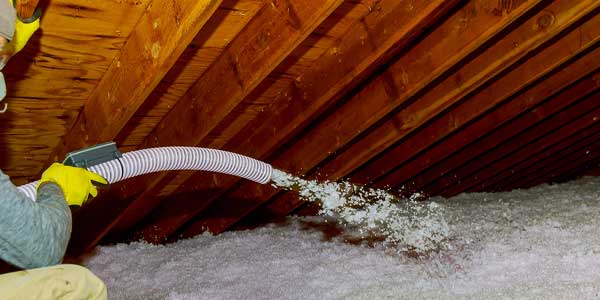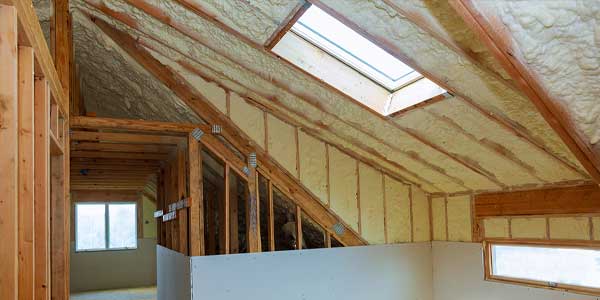St Louis - St Charles Insulation Company.


Basement
Most of the heating and cooling lost from your home originates with poor insulation, which means you need to determine which product works best for your property. Whether you are retrofitting an existing home or building a new one, consult with a St. Charles insulation contractor to get advice on whether blown-in insulation or spray foam insulation is better for you.
Let’s go over the differences between these two products so you can determine the best fit.
Blown Insulation
Blown-in insulation, or loose fill insulation, is comprised of loose particles blown into a wall or attic to fill all air gaps. There are many benefits that come with blown in insulation, such as:
1. Higher Efficiency
Blown-in insulation is more efficient than other types, such as fiberglass batts. This kind of insulation has a monolithic layer of insulation with no seams, performing 22 percent better than fiberglass batts. Blown in insulation is made up of a material called cellulose, which comes from recycled newsprint.
2. Easy Installation
Blown-in insulation is easy and relatively quick to install. Your insulation contactor will feed it into a blowing machine in the truck while another contractor is waiting in the attic to spread it from the hose. Two contractors adding fiberglass batts, on the other hand, would take twice as long.
3. ROI
The money you save on energy costs will pay off very well later, usually paying for itself in the first couple of years.
4. Comprehensive Coverage
Loose fill cellulose easily conforms to all the nooks and crannies in your walls and attic, meaning you get complete and comprehensive coverage. Due to its blown-in nature, it blankets all of your plumbing pipes, wooden crossbeams, cables and electrical wiring. Fiberglass batting can’t give you this kind of coverage.
5. Sound Dampening
Blown-in insulation prevents or dampen noises from getting into your main living space.
Spray Foam Insulation
Spray foam insulation is sprayed into an open wall cavity, sort of like paint, expanding to create an insulation barrier. After setting and expanding, it guards very well against wind, moisture, and exterior temperatures. It won’t settle or break down over time, unlike other types of insulation, which means you will enjoy a wise, long-term investment.
Traditional insulation allows energy to escape through spaces and gaps. With spray foam insulation, you can apply it to a variety of open-cavity areas such as basements, attics, crawlspaces, and more. Best part is, your HVAC system doesn’t have to work harder than it needs to in order to keep the interior temperatures regulated.
Here are some quick benefits of spray foam insulation:
- Efficiency – Because this product seals cracks and crevices, it’s much more efficient than traditional fiberglass batts.
- Weather barrier – It acts as a barrier to weather through all seasons.
- Eco-friendliness – Because it lowers energy requirements, spray foam is eco-friendly.
- Mold deterrent – Spray foam features inert polymers that inhibit the growth of bacteria and mold.
Energy Saving Insulation by Addict Insulation in St. Charles MO
Wondering whether blown-in insulation or spray foam insulation is best for your home in the St Louis or St Charles, Missouri area? Consult with our attic insulation contractors in O’Fallon MO today when you contact us at 636-233-7314.
Energy Saving BlogPopular Articles
- FAQs About Insulation in Missouri
- What Areas Should You Insulate Before Winter?
- The Greatest Risks to Your Home Caused by Poor Insulation
- Why Your Utility Bills Are So High and What You Can Do About It
- Can You Put New Insulation Over Old?
- Here Are 3 Ways Your Attic Could be Contaminated
- How Home Insulation Works in the Summer
- Tips and Tricks For Summer Insulation
- How to Fix Indoor Condensation
- Choosing the Right Spray Foam Contractor
- Why You Need Power Washing This Spring
- Don't Let Air Escape Your Home
- Tips For Saving on Your Energy Bills This Summer
- Should I Install a Radiant Barrier in My Home?
- Are You Wondering if Your Attic Has Enough Insulation?
- Do I Have to Replace Wet Insulation?
- Insulating Your Sunroom
- Should You Insulate Your Outdoor Spaces?
- All About Removing Insulation
- What to Know About Insulating a Crawl Space
- How to Spot Mold in Your Wall Insulation
- How to Prevent Moisture in Your Warehouse With Spray Foam Insulation
- What Factors Cause Heat Gain?
- The Problems That Come With Improper Insulation
- Insulation FAQs
- Why Should You Check the Insulation When Buying a Home?
- Why Seal and Insulate Your Home?
- Home Insulation: Safety and Health
- Should You Remove Old Insulation During Replacement?
- Can I Stay Inside My Home During Spray Foam Insulation Installation?
- Pros and Cons of Converting an Attic
- Pros and Cons of Converting an Attic
- When’s the Best Time to Insulate Your House?
- The Difference Between Blown Insulation and Spray Foam Insulation
- Is Your Garage Loft Too Hot or Too Cold? Heed These Tips
- 6 Health Benefits of Having a Quiet Home
- Insulation Prep is Critical For Installation
- The Dangers of Removing Insulation on Your Own
- What’s the Most Eco-Friendly Insulation?
- 7 Benefits of Spray Foam Insulation
- What is the Proper Insulation For Vaulted Ceilings?
- Signs Your Crawlspace Insulation Should be Replaced
- Why You Should Insulate Your Basement Walls
- Most Effective Ways to Soundproof Your Home Office
- How to Insulate an Old House
- 4 Tips to Make Your Attic More Energy Efficient
- Attic Insulation Problems: 5 Things to Look Out For
- What Causes Condensation on Interior Walls?
- How Deep Should Your Insulation Be?
- What to Consider When Choosing an Insulation Company
- Can You Add New Insulation Layers Over Old Ones?
- When Should You Remove Insulation?
- 7 Tips For an Energy Efficient Summer
- Creating a Healthy, Comfortable and Productive Workspace When Working From Home
- Why is Roof Ventilation Just as Important as Insulation?
- Why Spring is a Good Time to Insulate Your Attic
- 5 Signs of Damaged or Insufficient Insulation
- Is the Insulation in Your Walls Making You Sick?
- Under-Insulated Areas You May Be Overlooking
- The History Of Insulation.
- Pros and Cons of Attic Insulation
- Do You Need Insulation When Finishing a Basement?
- What is Drill and Fill Insulation?
- Which Insulation is Best for Garage Walls?
- How Air is Escaping Your Home and How to Prevent It
- 10 Things You Must Absolutely Insulate Before Winter
- 5 Reasons To Not DIY Insulation
- 5 Signs of an Under-Insulated Home
- 5 Benefits of Blown Insulation
- Cellulose vs. Fiberglass Insulation
- When is Insulation Removal Necessary?
- Tips to Keep Your Home Cool This Summer
- What is the Best Insulation for a Flat Roof?
- 5 Benefits of Power Washing
- Q & A About Insulation
- Reviews
- Energy Saving Blog






